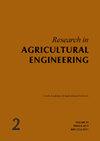Electrohydrodynamic, oven and natural drying of mint leaves and effects on the physiochemical indices of the leaves
Q3 Agricultural and Biological Sciences
引用次数: 2
Abstract
The efficiency of three modified plastic digesters (3.6 m3 each) using food waste for biogas generation in cooking food was evaluated. The experiment was laid out based on a completely randomised design. A plastic tank was modified as a biodegradation system for food waste digestion to generate a biogas. The biochemical and chemical oxygen demand ranged from 44.58 to 49.62% and 130.42 to 139.20%, respectively, before digestion, but decreased significantly (P < 0.05) after digestion. The pH of the fermenting slurry fluctuated (6.24–6.86) and an average biogas of 0.574 m3 (505–601 L·day–1) per day was generated from the three experimental waste proportions which would be sufficient to cook three meals per day for 3 to 4 people. The methane gas significantly increased (P < 0.05) while the carbon-dioxide significantly decreased (P < 0.05) at the peak of the biogas production. The generated biogas significantly cooked (P < 0.05) faster than kerosene, but not faster than liquefied petroleum gas. The flammable biogas generation and high significant (P <0.05) percentage change in the physico-chemical properties of the wastes after digestion implied high efficiency performance of the digesters modified from the plastic tanks.薄荷叶的电液动力、烘箱干燥和自然干燥及其对叶片理化指标的影响
评估了三个利用食物垃圾在烹饪食品中产生沼气的改良塑料消化器(每个3.6 m3)的效率。这个实验是在完全随机的设计基础上进行的。一个塑料罐被改造成一个生物降解系统,用于消化食物垃圾以产生沼气。消化前生化需氧量和化学需氧量分别为44.58~49.62%和130.42~139.20%,但显著下降(P < 0.05)。发酵浆液的pH值波动(6.24–6.86),平均沼气为0.574 三种实验废物比例每天产生m3(505–601 L·day–1),足以为3至4人每天烹饪三顿饭。甲烷含量显著增加(P < 0.05),而二氧化碳显著降低(P < 0.05)。所产生的沼气显著煮熟(P < 0.05)比煤油快,但不比液化石油气快。可燃性沼气的产生和消化后废物理化性质的高显著百分比变化(P<0.05)表明塑料罐改性的消化器具有高效性能。
本文章由计算机程序翻译,如有差异,请以英文原文为准。
求助全文
约1分钟内获得全文
求助全文
来源期刊

Research in Agricultural Engineering
Engineering, agriculture-
CiteScore
1.40
自引率
0.00%
发文量
21
审稿时长
24 weeks
期刊介绍:
Original scientific papers, short communications, information, and studies covering all areas of agricultural engineering, agricultural technology, processing of agricultural products, countryside buildings and related problems from ecology, energetics, economy, ergonomy and applied physics and chemistry. Papers are published in English.
 求助内容:
求助内容: 应助结果提醒方式:
应助结果提醒方式:


